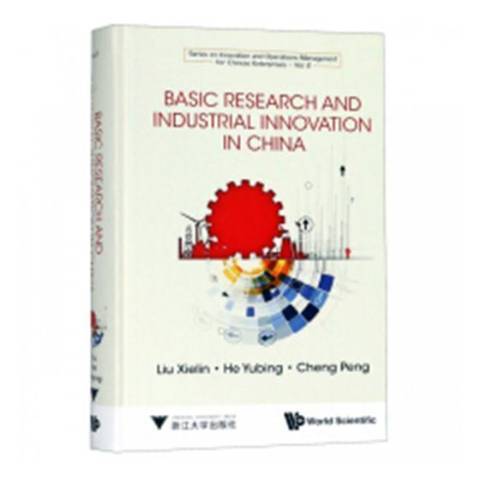《Basic Research and Industrial Innovation in China》是2018年浙江大學出版社出版的圖書。
基本介紹
- 中文名:Basic Research and Industrial Innovation in China
- 作者:Liu Xielin、He Yubing、 Cheng Peng
- 出版時間:2018年
- 出版社:浙江大學出版社
- ISBN:9787308182218
- 類別:工業技術
- 開本:32 開
- 裝幀:精裝

《Basic Research and Industrial Innovation in China》是2018年浙江大學出版社出版的圖書。
研究項目 各類項目數56,研究總經費757 萬澳元,承擔有中澳JCG雙邊合作項目、澳大利亞ARC Linkage項目、ANLEC項目、ACARP項目、國家973項目子課題和國家自然科學基金等項目。2020 ARCResearch Hub for Australian Steel Innovation,380,838, Funding body: BHP BillitonInnovation Pty Ltd In-situ study of the ...
Industrial Catalysts——Towards Innovation and Technology Commercialization Investigation Group on Catalysis,Division of Chemistry,CAS Potential,Tendency and Countermeasures for Resources of China——A Proposal to Establishing a Resources-Saving...
Chapter 4 Research and Development Activity and Innovation of Enterprises 64 Section 1 R&D Activity of Enterprises 64 Section 2 R&D Activity of Industrial Enterprises 68 Section 3 R&D Collaboration and Technology Acquisition of Industrial Enterprises 78 Chapter 5 Science and Technology Activity of ...
1.5 Research on Wenzhou model from an overseas perspective 1.6 Prospect of Wenzhou model Chapter 2 Wenzhou Model: Institutional Change and System Innovation 2.1 Initial conditions of regional economic institutional change 2.2 Basic features of quasi-demand-induced institu...
Basic Research 社會發展科技 Science and Technology for Social Development 農業科技 Science and Technology for Agriculture 科技奧運 Olympic Science and Technology 高新技術及其產業 Hi—tech and it's Industries 電子信息技術 Electronics and IT Technologies 先進制造技術 Advanced Manufacture Technologies 生物工程與...
Section 1 Research and Development Activities of Enterprises Section 2 Research and Development Activities in Industrial Enterprises Section 3 Patents and Development of New Product in Industrial Enterprises Section 4 Cooperation among Industrial Enterprises, Universities, and Research Institutes and ...
scientificinnovation as thefirstimpetus, regarding ruralinformatization asabreakthrough, and regarding agricultural systeminnovation asasafeguard, and explore a new type of agriculturalmodernization which is suitforthespecificsituationin china and different from thewest'sindustrial...
Technology Policy Innovation of Encouraging Intensive Utilization of Natural Resources Personality Difference between Civil Servants and Enterprise Administrators: An Empirical Study Research on the "Migrant Labor Shortage" Problem in China The Analysis of Farmland Scale Management and System Innovation Research...
computer linker mold and other factory automation components. Our products are mainly sold to China, Europe, America, East Asia and Southeast Asia. We are able to make and check customised products according to world-brand standard as well as GB, JIS, DIN and AISI international industrial standa...
11. Bingjiang Luan, Junbing Huang, Hong Zou, Cheng Huang. Determining the Factors Driving China's Industrial Energy Intensity: Evidence from Technological Innovation Sources and Structural Change, Science of the Total Environment , 2020(737).12. Junbing Huang, Bingjiang Luan, Xiaochen Cai, Hong...
跨數據整合構建健康分析指標體系,健康指數研究中心第四次專題研討會:健康指數助力政府數位化轉型,山東大學與山東健康醫療大數據管理中心共同舉辦,線上會議模式,2022.01.22 CircularSupply Chain Management: Basic Concepts and Applications, Seminar for Research and Publication for Doctoral Program in Industrial ...
19. Flynn, B. Zhao, X. and Roth A. “The myth of the dragon: Operations management in today’s China”. Business Horizon. Vol. 50, No. 3, May/Jun 2007, 177 20. Zhao, X., Flynn, B., Roth, A. V., “Decision sciences research in China: current status, opportunities and ...
2008,Information visualization of special news text sets,Proceedings of the International Conference on Information Management, Innovation Management and Industrial Engineering,2008.12,EI收錄 2008,基於因子分析的振興東北概念股投資價值分析,統計與決策,2008年第10期 2007,Impact of Integrated Application of...
Integrating Green and Sustainability Aspects into Life Cycle Performance Evaluation Research Concept for Sustainable Mobility in Metropolitan Areas Utilizing Quality Function Deployment to Evaluate and Design Wastewater Treatment Systems Defining the Dimensions of Human Work for Industrial Sustainability Assessment ...
4. “Transitional China” (individual) Tibet People’s Publishing House 2000 5、《產業結構演進與稅收發展》 (合著第一作者) 中國稅務出版社 2004年8月已出版 5. “Evolvement of industrial structure and taxation development” (cooperative work, the first author) China Tax Publishing House August 2004...
In Jan., 2013 EADING Holdings Co. LTD. was founded in Jan., 2013, which three industrial clusters comprising of IT application and innovation, IT technology research and development and ITindustry investment were formed.In December, 2012 First EAsmart store and EApower base grandly opened in ...
45. Liu, Y., Y. Liu, R. Ruan. 2012. Rapid determination of 5-hydroxymethylfurfural by ultraviolet spectrophotometry in glucose diphasic hydrolysate. International Conference on Energy, Environment and Sustainable Development (ICEESD 2011), 10/21-23/2011, pp 1713-1717, Shanghai, China.46. Chang...
...114Striving for Quality inTransforming Scientific and Technological Achievements ...118Academic Fraud Violates the Basic Principles of Scientific Research... 122Sun Baoguo: Science Knows No Borders, but Scientists Have Home Countries...128Four-Time National College Entrance Examination Candidate Who ...
Huangqiao Industrial Park is in the south of Huangqiao Town, the Jiangsu modern equipments technology park and the cooperation base of China and Austria. The total area of the park is 18.6 square meters. The 5-square-meter key area has realized “7 Availabilities 1 Leveling”(water, ...
Ⅲ. China has basic conditions to develop low-carbon economy during "the Twelfth Five-year Plan" period Ⅳ. Developing low-carbon economy should emphasize on institutional innovation Section IV Transition from Public Goods Shortage to Equality of Basic Public Services in Urban and Rural Areas Ⅰ. ...
The Seminar of Professor Zhi Xun HUANG’s 55 Anniversary of Natural Science Research will be held by Communication University of China / 428 Pro fessor Zhi Xun HUANG of Communication University of China is Granted the Special Innovation Award by the China High Tech Industrial Originality Awards / ...
Yu M., Wang S., Wang N., Wu Y., Li L., Lu X.*, 2024. Magnetic dummy-template molecularly imprinted polymer with an ultrathin shell for selective enrichment of geosmin in water sample. Journal of Industrial and Engineering Chemistry 136, 349–358 Chen X., Ma Y., Furst K., Tan Q...
[14]HengqianZhao,Xiongjun He. The development and innovation of modern suspension bridge in China. Applied Mechanics and Materials. 2014,587-589:1435-1438(EI收錄)[15]王江,何雄君,李梁. 高寒地區橋面GFRP筋-瀝青混凝土鋪裝層結構溫度應力分析. 武漢理工大學學報(交通科學與工程版),2014,38(3):...
2. X Lim, WH Lam, AH Shamsuddin (2013) Carbon credit of renewable energy projects in Malaysia, IOP Conference Series: Earth and Environmental Science 16 (1), 012058.3. WW Jian, Y Zhang, YC Song, F Chang, YC Zhan, Y Liu, WH Lam (2012) Research progress of the basic physical ...
